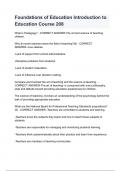Class notes
LPC (BPP UNIVERSITY) TAX & BUSINESS ACCOUNTS FULL REVISION NOTE
- Course
- Institution
- Book
COMPLETE REVISION NOTE FOR TAX AND BUSINESS ACCOUNTS ON THE LPC JAN START 2017 AT BPP UNIVERSITY. I'd highly recommend purchasing this as I've summarised all of the main points and content into this revision document - the actual business tax workbook was 92 pages and the accounts workbook was 112 ...
[Show more]













